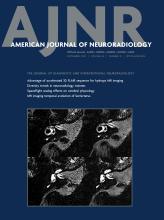We read the article by Zhu et al1 with interest. The authors provided a new method to automatically segment intracranial thrombus on NCCT and CTA in patients with acute ischemic stroke (AIS) using a deep learning (DL) model. The authors should be congratulated for reaching optimal results such as predicting the thrombi length and volume, which were correlated with the manual segmentation (r = 0.88 and 0.87, respectively; P < .001) in the internal cohort with similar results in the external cohort length (r = 0.73) and volume (r = 0.80) with a sensitivity of 94.12% and a specificity of 97.96% in differentiating large-vessel occlusion (LVO) from no LVO (including medium vessel occlusion and no occlusion). Their study gives a new indication of the development of a quantitative automated method for thrombus segmentation.
However, some limitations and concerns should be considered when interpreting the results.
First, the limitations of automatic thrombus segmentation on CT models, including partial volumes, artifacts, and calcifications, were mentioned in the text. To eliminate partial volumes and artifacts from the analysis, the authors excluded patients whose images had thick sections (>2.5 mm), irremediable coregistration errors, severe motion artifacts, and beam-hardening artifacts. In our opinion, as also partly described in the text, these represent selection bias. In addition, regarding calcifications, which, in our opinion, represent the most important problem in the evaluation of vessel patency (mural or dural calcification versus thrombus), nothing was said or proposed.
Moreover, it is not clear whether in the internal validation cohort or external validation group, patients with acute hemorrhagic pathologies were included. In a previous study by Schmitt et al,2 instances of false-positives and false-negatives that a DL model might include in the detection of hemorrhagic stroke were described. In particular, the DL model could not depict and differentiate an SAH in the cisterns by means of a vessel clot (hyperdensity linear thrombus), which could be concurrent in the clinical scenario of suspected AIS. Another example could be basilar artery hyperdensity due to an aneurysm that could be mistaken for thrombus occluding the posterior circulation. It would be interesting to learn whether these patients were included, and, if not, how the authors would plan to address this previously described limitation of the DL model. Likewise, patients with postoperative and postischemic defects, tumors, hyperattenuated media sign, cavernomas, malformations, or arteriovenous fistulas were not included in the evaluations. All these conditions represent incorrectly flagged findings and missed findings as described by Seyam et al.3
Although we applaud the authors for the manual thrombus segmentation and DL model training methodologies, we believe that the findings were considerably impacted by the authors' strict patient selection. The 100% specificity value, which should not, in our opinion, be included in medical research literature, would therefore be justified.
In this regard, it is yet unclear whether this model can be incorporated into current daily hospital routine.
Footnotes
Disclosure forms provided by the authors are available with the full text and PDF of this article at www.ajnr.org.
- © 2023 by American Journal of Neuroradiology












